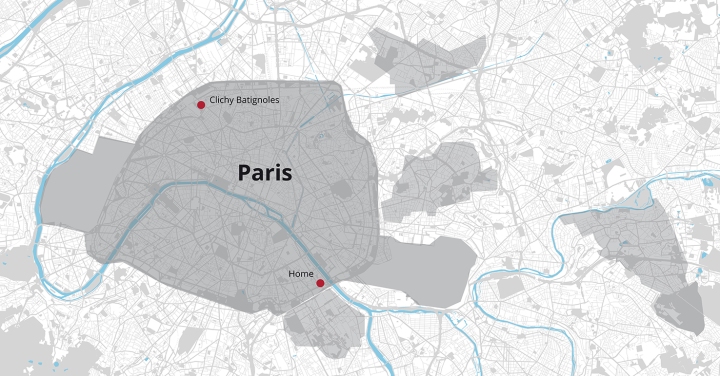During our research project ANA goes Europe, we investigate the role of the architect in the future European housing assignment. The trip we made this autumn led to Paris and its suburbs. The French solutions for matters such as living quality, densification, transformation of the Grand Ensembles and gentrification are instructive for the Dutch practice.

Paris is actually a small city. The city border lies at the Boulevard Périphérique. Within this ring, 2.3 million people live on 105 km2 either 22,000 inhabitants per km2. In comparison, the municipality of Amsterdam has 853,312 inhabitants living on 219 km2 either about 4,000 inhabitants per km2. And as if this is not dense enough? The city of Paris is currently working on a number of very complex projects to further densify the compact city.
La Métropole du Grand Paris
For the last years the housing market in Paris has been under enormous pressure. The average purchase price for an apartment is now € 10,000 per m2. This is unaffordable for most families. Fortunately, France has a system of social housing that is much more extensive than ours. In France they use different price levels depending on the composition of the household and income. Households with a gross income up to € 70,000 per year qualify for social housing. This system enables a diverse and larger group of people to live in the city.
The social rental housing is realized by various housing associations, never the less they cannot meet the demand. As in Amsterdam there are huge waiting lists. At Paris Habitat, the largest housing association in the city, alone 180,000 people are on the waiting list.
The fact that the municipality of Paris is small and surrounded by no less than 350 municipalities, each with its own management, also explains the enormous contrasts in density between inside and outside the ‘ring’. Paris would love to maintain its inhabitants and provide housing for everyone. For this reason the Métropole du Grand Paris has recently been introduced. A partnership between 131 municipalities, including Paris, with the aim of strengthening forces, combating inequalities between the various municipalities and strengthening the role of the Paris region in the world.
Densification of the dense city
The city of Paris wants to increase the share of social housing from 21% as it is now up to 30% in 2030. A very ambitious aim, taking into account that there are almost no building plots left and all remaining construction sites are extremely complex. At the moment a number of locations are under development, many of which lie directly next to the Boulevard Périphérique.
We have spoken to Mélanie Moisain and Anna Carnac of Paris Batignolles, an organization that manages the big building projects for the city of Paris. We talked about the policy of the city of Paris regarding residential construction and about a number of recent development areas such as Clichy Batignolles, a housing project on a former railway yard. Clichy Batignolles has high ambitions: amongst others a park of no less than 10 hectares, 50% social housing, a large program of offices and facilities, moving and overhauling the shunting yard, and very high density housing. According to almost everyone we have spoken to high-rise is not an option, Paris suffers from a serious high-rise trauma since the city built a number of mega high towers in existing neighborhoods in the 1970s. The absolute high (or low) point being the Tour Montparnasse. Recently the city decided on building a bit more high-rise, but certainly not too high and very carefully fitted into the urban fabric. By selling al lot of building land, the city of Paris can finance ambitious development like Clichy Batignolles.
Home, hybrid high-rise
An illustrative statement that shows all ambitions of the city of Paris is the project Home, in Masséna-Bruneseau by Comte & Vollenweider Architects and Hamonic + Masson & Associés. This hybrid ‘tower block’ consists of a block volume that follows the street alignment, defines a clear boundary between the public street and the collective courtyard, and has a public program in the plinth. On the plinth are two residential towers. The highest and most prominent tower contains social housing (€ 10-15 / m2 / month) and the lower tower contains owner-occupied apartments (€ 10,000 / m2). Although the building height of the towers is not that high, only 50 meters, compared to the proposed residential towers in the Amsterdam Sluisbuurt (125m) or in the center of Sloterdijk (90m), this project does show that it is very well possible to develop new urban typologies. Typologies that respond to the need for high densities, introduce new living qualities such as large private outdoor spaces, generate pleasant urban spaces such as well-functioning public streets and collective courts and bring about a social mix.








